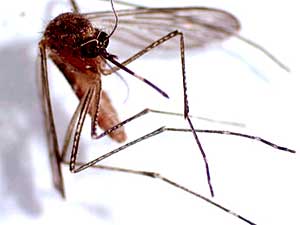|
Audio
Photos
Resources
Your Voice
|
It's time to watch for West Nile virus
June 25, 2004
It's officially summer, and the beginning of another West Nile virus season. Every week the number of positive cases of this mosquito-borne illness increases. In North Dakota, 12 birds have tested positive, while Minnesota reported its first positive case in a bird Thursday. And in South Dakota, two people have already come down with West Nile virus. That's a month earlier than the first human case was reported last year. There are differing opinions about how the virus is moving across the United States. But the one thing experts agree on is the only way to reduce the illness is to kill mosquitoes.
Sioux Falls, S.D. — Every morning Jerry Krueger checks mosquito traps. This one is hanging from a tree limb in a wooded area of a city park in Sioux Falls.
"The trap is programmed to come on at dusk and go off at dawn," says Krueger. "These little trap doors open up like that when the blower runs, and traps mosquitoes down here. We have a CO2 (carbon dioxide) tank down here, and a battery."
 | |||
Krueger says the carbon dioxide, and a light, attract the mosquitoes, which are sucked into a mesh net by a fan. About two dozen are trapped in this particular net.
Krueger checks 13 traps scattered around the city every day. He gathers hundreds of the mosquitoes, takes them back to the city health department, and puts them in the freezer.
At the lab, the mosquitoes are identified by species and counted.
"Some of the mosquitoes have scales, some of them have different colorations, some of them have bands on their proboscis or their legs," explains Dorothy Franklin, the health department's environmental health supervisor. "The Culex tarsalis is extremely easy to identify, fortunately, and that's the one that we're most concerned about in this area."
The Culex tarsalis mosquito is the only mosquito that carries the West Nile virus. Each one caught in a trap is tested to see if it has the virus. Under a microscope it may be easy to identify because of the stripes on its legs. But when a mosquito lands on your arm for a blood meal, there's no way to know if the bite will just itch -- or make you sick. That's why the city of Sioux Falls is counting and keeping track of where the diseased mosquitoes are found.
 | |||
Sioux Falls has the most comprehensive mosquito control program in South Dakota. Next week, city health officials will train their counterparts from other communities. Franklin says for communities just starting a mosquito control program, it's almost too late for them to make a difference in the mosquito population for this year.
Denise VanRoekel coordinates Sioux Falls' mosquito control program. She supervises a crew of about 15 seasonal employees, who drive up and down every street to monitor prime breeding areas. They use ATVs to get in the back areas of the parks and bike trails. At night, when the weather is calm and the mosquitoes are out, they spray the entire city.
Last year was the first time Sioux Falls controlled the mosquito population with spray. VanRoekel says they sprayed four times.
"There's no way to determine how many we're going to do. We did one last week. There's still a lot of adult mosquitoes out there, so we are just finishing up a second round through the city. And we've also expanded out into the county," says VanRoekel.
"Next week, due to the Fourth of July weekend, there will be a lot of people out and about when mosquito activity is at its highest, and we do plan on doing another one," says VanRoekel. "Hopefully, between the three we will get a really good knockdown of all the mosquitoes that emerged after the floods."
 | |||
VanRoekel says any future spraying will depend on what they find in the traps.
The city has tried to kill larval mosquito by placing pesticide disks in standing water, but recent heavy rains have washed away the larvacide. That's why the city is concentrating on spraying to kill the adult mosquitoes. The spraying only kills mosquitoes it comes in contact with. VanRoekel says they're also reapplying the larvacide, but its effect will take time.
Last year more than 1,000 people contracted West Nile in South Dakota, and 14 of them died. South Dakota had the second highest number of confirmed West Nile cases in the country.
Environmental Health Supervisor Dorothy Franklin says because the virus is still new, there's a lot they don't know. For instance, there are lots of questions about immunity. It's possible that people who've developed the virus, also develop an immunity. But research doesn't show that conclusively. And Franklin notes only a small percentage of the population have been infected.
Health officials say they're watching for another mosquito-borne illness called Rift Valley fever and it's more deadly than West Nile virus. Rift Valley fever has been showing up in Africa, and hasn't arrived in the United States. But while only one type of mosquito carries West Nile, as many as 30 mosquito species can transmit Rift Valley fever.
|
News Headlines
|
Related Subjects
|

